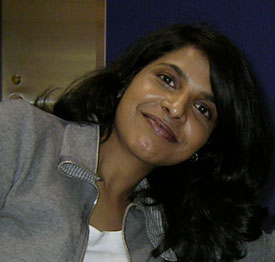A Differential Equation Model for Crab-Mussel Interactions
By Karthika Swamy Cohen
Blue mussels have declined drastically in regions such as the Gulf of Maine, where their population has decreased by over 60 percent in the last four decades. The exact reasons for their decline are not known, but one specific factor has been of interest to scientists: invasion of the community by epibionts – organisms that live on the surface of other living organisms.
At the SIAM Conference on Mathematics of Planet Earth held last week in Philadelphia, Pa., Rana Parshad of Clarkson University explored the effect of epibionts on blue mussels mathematically.
Blue mussels are severely declining in many areas, such as the Gulf of Maine.
Parshad described an ordinary differential equation model for crab-mussel interactions in the presence of epibionts. The model employs classical optimal foraging theory and anti-fouling defense mechanisms of mussels. An invasive epibiont, the colonial ascidian Didemnum vexillum, was used in experiments.
Parshad began by describing the biological interactions that have likely influenced this observed decline of blue mussels. In many communities, predators play an important role in a prey’s population dynamics. Surface features of a prey—such as, form, size, texture, consistency, smell, taste, and color—are crucial for a predator to recognize and consume its prey. A modification of this interface can hence affect this synergy. Because epibionts grow on the surface of organisms, they can alter the surface of the species they inhabit, thus making them unrecognizable to their predators. This, in turn, has an impact on consumer-prey interactions.
Epibionts are altering predator-prey interactions between crabs and blue mussels.
The epibionts living on the surface of blue mussels thus affect their interactions with crabs that prey on them. “What we think is happening is that this invasive epibiont species is affecting mussel populations via an indirect effect that is messing with what predators of mussels actually do,” explained Parshad.
The epibiont alters the basic optimal foraging approach ratio E/T, where E is the amount of energy that a prey provides to the predator and T is the total handling time required by the predator to find and consume its prey.
“Simply put, any predator wants to maximize energy by spending the least amount of time,” said Parshad. “It tries to maximize energy from whatever it is hunting and minimize the searching and hunting time.”
The epibiont, an introduced Ascidian colonial species called Didemnum vexillum, arrived in the Gulf of Maine in the 1970s.
Crabs prefer mid-sized mussels, which provide an ideal E/T ratio. When they encounter an unusually large mussel instead, they will choose not to break it because that would require too much handling time. Small-sized mussels, on the other hand, require less time by predators to process, but also provide much less energy.
Crabs cannot easily break mussels that are covered with epibionts – the handling time for a crab in this case is about six times more. So, in the presence of epibionts, crabs switch their preference to smaller juvenile mussels, which have a protective layer on them preventing epibionts from growing on them.
Parshad and his colleagues model crab-mussel interactions via a system of four ordinary differential equations in the presence of an invasive epibiont, based on a classic one-predator two-prey model. The model factors in the birth rate of juvenile mussels, the probability that a crab will attack juvenile versus adult mussels, energy gains from an adult versus juvenile mussel, and a loss term depicting predation.
A crab eating a clean mussel. Predation is a primary cause for species decline.
The various terms are made dependent on the epibiont to determine the latter’s impact. The team found that in the absence of an epibiont, the crab preys on the adult mussel as is its preference. In the presence of an epibiont, it attacks juveniles.
By plotting the attack rate on juveniles versus handling time of adults, the team also found that once the handling time is behind a certain threshold optimally, the attack rate becomes zero, indicating that perhaps juveniles seek some sort of refuge at that point. The researchers employ optimal control methods to predict various outcomes in relation to the different species involved.
The work not only has significant implications for rescuing blue mussel populations from decline, but also helps provide important insight into predator-prey community dynamics.
Epibionts alter the dynamics between crabs and juvenile and adult mussels.
 |
Karthika Swamy Cohen is the managing editor ofSIAM News.
|